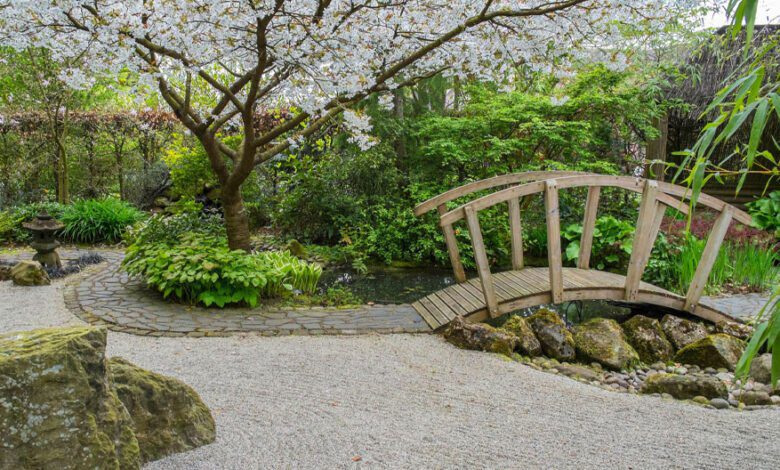Create an Enchanting Jungle Garden Oasis with These 10 Ideas

The sights and sounds of a lush, vibrant jungle garden offer an enticing escape from urban life. With layered planting, meandering pathways, and touches of tropical decor, you can create a serene outdoor haven right at home. This comprehensive guide explores 10 enchanting ideas for crafting your own jungle garden paradise. From lighting concepts to plant choices, wildlife habitats, and maintenance tips, transform your landscape into an immersive tropical getaway.
Introduction
The allure of the jungle holds an enduring and mystical fascination. Images of verdant rainforests with towering palms, fragrant flowers, and birdsong have captivated imaginations for centuries. While few of us may venture deep into the actual Amazon or jungles of Southeast Asia, incorporating the vibrant essence of these landscapes into our own outdoor spaces allows us to experience a taste of paradise close to home.
Bringing a slice of the jungle’s vibrant, lush beauty into our gardens and landscapes allows us to reconnect with nature in profound ways. Studies show spending time among greenery and wildlife improves mental health, reduces stress, and enhances creativity. The life-affirming magic a flourishing jungle garden ushers in makes infusing tropical touches into our surroundings extremely rewarding.
This comprehensive guide details ten eye-catching ways to cultivate an authentic jungle garden oasis brimming with plants, flowers, water features, and dynamic vertical elements. By artfully blending these components, you can craft a mini rainforest panorama and escape the pressures of daily life. Let your imagination run wild as we explore exciting jungle garden ideas!
Understanding the Jungle Garden Aesthetic
Before diving into techniques, first we must define the distinguishing hallmarks of a jungle garden. These landscapes aim to recreate the ambiance of a rainforest or tropical wilderness setting.
Key Characteristics
- Abundant, lush vegetation on multiple vertical levels
- Diversity of exotic, tropical foliage and flowers
- Meandering and natural-looking pathways
- Water features like ponds, streams, or fountains
- Appearance of an established, mature ecosystem
- Wildlife-friendly with birds, butterflies, etc.
- Secluded, private garden rooms and seating spaces
By incorporating structural and planting elements aligned with these traits, we can successfully channel the mood of a jungle environment. Blending numerous plant varieties while allowing growth to shape itself organically is critical in avoiding a overly manicured look. Now let’s explore 10 dynamic ideas to put this aesthetic into action!
The Appeal of Crafting an Urban Jungle
In today’s predominantly concrete-dominated urban centers, creating an immersive jungle landscape offers physical and mental respite. These living sanctuaries muffle noise pollution, filter air, lift moods, and provide critical wildlife habitat as well.
Building a jungle garden taps into our innate human affinity towards nature.otransforms outdoor areas into relaxing escapes from modern life’s constant stimulation. Unplug inside your own rejuvenating refuge as we review inspirational jungle garden concepts.
Idea #1: Layered Planting
The hallmark of a thriving jungle ecosystem lies in its rich vertical structure. Through layered planting, we can replicate the towering canopy effect and sense of enclosure. Selecting an array of plants in a variety of heights, shapes, and sizes allows us to recreate the jungle’s diverse panorama.
Achieving a Multi-Tiered Look
- Plant tall canopy trees like Live Oaks, Evergreens, Redwoods or flowering Cherries to frame the space and impart height. Ensure proper sunlight and space for future growth.
- Next, incorporate medium-height trees like Japanese Maples, Magnolias or flowering Crabapples for a lush mid-level canopy.
- Shrubs like Camellias, Azaleas and Hydrangeas supply swathes of smaller foliage.
- Finally, use vines, ferns and ornamental grasses to form a vivid green understory and foster that wild jungle feel!
By thoughtfully staggering and blending all levels of plants, your landscape transforms into a dynamic, multidimensional zone rather than remaining flat and static. This complex interplay of varying greenery transports viewers straight into the humid verdure of a jungle!
Idea #2: Incorporating Water Features
No jungle panorama feels complete without gently flowing water integrated thoughtfully into the landscape. The auditory stimulation and serene presence water lends transports observers even deeper into an exotic retreat.
Adding beckoning water elements creates an inherently peaceful ambiance ideal for relaxation. Strategically placed alongside meandering pathways, water also beckons visitors to explore your mini wonderland further!
Suitable Water Features
- Small ponds with water plants and perhaps wildlife like koi fish or frogs
- Splashing fountains surrounded by river rocks or lush ferns
- Gentle waterfalls cascading over interestingly-shaped driftwood
- Naturalized streams flowing below arched footbridges before emptying into lively ponds
Take care to select water features matching your climate and site conditions. Ensure proper installation and maintenance to avoid issues with leaks or poor water clarity down the road. Light strategically placed lights along pond edges or within fountains to supply magical illumination once evening sets in.
Now let’s survey perfect plant selections to complete the verdant jungle vision!
Idea #3: Exotic Plant Selection
One of the keys to constructing an authentic exotic oasis lies in choosing plants with a definite tropical allure. Vibrant blooms, dramatically shaped leaves, fantastic textures and SPACEs pique interest and underscore the destination theme. Take care only to select species well-adapted to your local environment. Site characteristics like sunlight, soil chemistry and hardiness zones guide proper plant choices to prevent frustration down the road.
While space precludes an exhaustive list, several plant types stand out as exceptional jungle garden candidates across numerous climates.
Great Jungle Plant Picks
- Cannas – These tropical perennials produce magnificent flowers closely resembling orchids from late spring until frost. Their huge leaves bring mega-watt jungle texture.
- Elephant Ears – For super-sized drama, few plants deliver more fantastically oversized foliage than Elephant Ears. Their colossal leaves reach over 4 feet wide in some varieties!
- Bird-of-Paradise – As one of the most iconic tropical plants, the uniquely shaped Bird-of-Paradise flower simply screams jungle flair.
- Bromeliads – With their urn-shaped rosettes housing water, colorful bromeliads ooze jungle ambiance while supporting tree frogs and salamanders.
- Ferns – Forming lush clusters, moisture-loving ferns conjure images of prehistoric jungles instantly. Their airy, vibrant greenery broadcasts a lush planting foundation.
- Palms – No tropical environment vision emerges fully-formed minus gracefully arching palms. Many hardy varieties like Sago Palm withstand winter freezes while lending island atmosphere.
This sampling of suggestions highlights just a few broad plant categories suitable for jungle garden development. Avoid feeling limited by this starter set though! Additional possibilities abound for intrepid gardeners.
Now let’s pivot to thoughtful design concepts centered around building captivating circulation routes to move through your personal jungle retreat.
Idea #4: Pathways and Walkways
A fundamental landscape design principle emphasizes guiding visitors fluidly through spaces via intuitive circulation components. In jungle garden contexts, meandering pathways underplanted with lush foliage or groundcovers enhance the immersive tropical experience significantly. Wandering along these corridors, observers brush against jungle plants while traversing through varied garden rooms and surprise reveals.
Materials and Design Elements
- Narrow footpaths through densely planted beds elicit adventuresome jungle trek sensations
- Wider pathways with arched arbors work well also. Underplant these routes with ferns or lilyturf for tropical verdancy.
- Wood-chip trails offer budget-friendly options, just ensure proper edging and containment measures first.
- Stepping stone pathways present another natural material well-matched to the jungle theme. Choose interesting stone shapes and embed securely to prevent shifting.
- For fancier walkways, interlocking concrete pavers or bricks in earthy colors lend tropical charm.
- If drainage presents challenges, elevated boardwalks keep visitors’ feet dry while facilitating air circulation to plant roots below.
By incorporating dynamism and meandering curves throughout all circulation networks, visitors feel drawn deeper into successive garden scenes. Analyze and improve existing paths or introduce additional ones to augment jungle immersion.
Idea #5: Utilizing Vertical Space
In chapter one we reviewed critical reasons why embracing vertical layering creates essential jungle garden foundations. However, introducing dedicated vertical planting into the overall three-dimensional composition multiplies tropical richness markedly.
Vining plants clambering upwards instantly amplify jungle sensations through increased density and enclosure. Structures supporting climbing foliage generate living walls and garden partitions brimming with plants unavailable at ground level. Vertical gardens also optimize smaller growing areas in urban lots by capitalizing on unused airspace.
Dynamic Vertical Elements
- Lush walls of climbing flowering vines like passionflower, clematis or even grapevines
- Obelisks wrapped with annual morning glories to create towers of blooms
- Arbors and pergolas intertwined with vines to form cool green tunnel effects
- Living walls of staghorn ferns or orchids attached onto tree boughs or driftwood sections
- Hanging basket gardens on pulley systems enabling raising or lowering plant groupings
While embracing verticality requires slightly more planning and maintenance vs standard beds, the visual rewards merit extra effort. Raising plants upwards expands your garden’s plantable space significantly while amplifying the jungle atmosphere markedly.
Onward to our next section covering creative ideas for decorative items supporting the overall rainforest narrative!
Idea #6: Adding Tropical Touches with Accessories
Thus far we have reviewed major structural and planting components essential for fashioning a transportive jungle environment. However, well-chosen decorative accents add important supplemental flair helping seal the overall imaginative effect.
Playfully blend interesting accessories like modern tropical furniture, repurposed wood items with ironwork touches or carved dark wood seating arrangements. Perhaps adorn patio areas or garden alcoves with hanging rattan pod chairs ideal for peaceful relaxation amidst surrounding green abundance. Strategically placed sculptures, containers or even driftwood partly submerged in garden streams inject artistic nuance.
Review these inspiring jungle accessory concepts before finalizing design schemes:
- Monochromatic modern patio furniture in black or white to contrast lush greenery
- Colorful textiles like bamboo blinds or jungle print curtains for ceiling enclosure
- Fragrant ornamentals like gardenias, orange trees or jasmine to amplify sensory experience
- Wooden masks, totem poles or other tribal-inspired sculptural pieces
- Stone garden lanterns housing glass enclosed candles to impart flickering ambient light
- Strategically-placed fruit trees like Banana, Mango or Papaya
- Cascading orchids flowering in interesting containers like suspended baskets or mounted onto trees
Infusing thoughtful ornamental touches throughout your emerging jungle landscape quickens its transformation into fully-realized status. Avoid overdecorating though, as restraint allows the plant life to shine as main events.
Magical lighting effects after dark further enhance jungle atmospherics. Discover inspiring illumination ideas in our next segment!
Idea #7: Lighting for Ambiance
Skillful illumination transforms landscapes after dusk by introducing captivating lighting effects. In jungle gardens, atmospheric lighting entices visitors to linger longer while amplifying wonder and drama.
Lighting Tips for Jungle Gardens
- Spotlights aimed upwards at palm canopies or stands of bamboo bathe foliage in moody backlighting
- Rope lights or lanterns hidden within dense shrubbery emit an alluring glow to pique curiosity
- Underwater pond or pool lights in blueish tones suggests refreshing tropical waters for night swims
- Tiki torches along jungle garden pathways create festive flair while keeping biting insects at bay
- Outdoor floor uplights or floodlights aimed at interesting textured barked trees showcase intriguing patterns
Avoid bright, glaring security-style floodlights as these undermine mood. Instead opt for strategic placement of lower-wattage compliant bulbs. If possible, put lighting on timers or photosensors to reduce energy consumption and simplify use long-term.
Now that we have reviewed key structural enhancements and decorative finishing touches, we shift focus towards creating vital habitat supporting diverse wildlife drawn to the abundant resources a thriving jungle landscape supplies.
Idea #8: Creating a Wildlife Habitat
A hallmark characteristic of any high-functioning garden involves its ability to sustain varied organisms comprising collectively balanced ecosystems. Emulating attributes of mature jungles allows us to shepherd rich biodiversity within cultivated spaces as well.
Ways to Support Wildlife
- Plant selections catering to native bees, hummingbirds and butterflies seeking nectar or host plants
- Providing clean water sources via installed ponds, fountains or even simple bird baths
- Strategic placement of nesting boxes to attract avian residents
- Allowing leaf litter and vegetation debris to accumulate as shelter for insects and other invertebrates
- Building brush piles from pruned growth supplying refuge for small mammals and amphibians
- Maintaining areas of long grass left unmowed to accommodate ground nesting birds
With conscientious planning, jungle gardeners can foster thriving, sustainable backyard ecosystems filled with colorful or songful wildlife. This dynamic energy augments the tropical atmosphere notably while delivering balancing ecological benefits.
Idea #9: Privacy and Seclusion Techniques
In addition to nurturing habitat diversity, mature rainforest jungles harbor many sheltered sub-spaces ideal for quiet contemplation away from broader surrounds. Seeking privacy serves as a fundamental human need. By employing clever planting arrangements or structural screens, we can carve out intimate jungle garden rooms eliciting sensations of productive retreat.
Supplying Privacy
- Living wall perimeter hedges using lush evergreen shrubs like Podocarpus or Ficus
- Vine-covered pergolas and ceiling canopies for sequestered seating spaces
- Weeping trees like Weeping Willows or Weeping Cherries help veil private zones
- Lush bamboo groves enclosing contemplative gravel and stone seating areas
- Secret garden alcoves framed by surrounding jungle planting
Analysis of existing circulation patterns and views guides effective privacy augmentation. Strive to incorporate a balance between open lawn spaces and discreet hideaways aligned with overarching project goals. Visitors appreciate options to alternate between social to introspective moments!
For our final thematic segment, we share critical maintenance best practices helping your jungle garden thrive for years while avoiding easily prevented pitfalls.
Idea #10: Maintenance Tips for a Jungle Garden
While jungle landscapes exude carefree appeal, certain essential care practices support sustained plant performance season after season. Prioritizing fundamental garden stewardship optimizes growth while averting disappointing declines or failures. Let’s review key maintenance tips:
Seasonal Care Basics
- Enrich planting beds each Spring using aged compost or organic mulch to promote vigor
- Apply well-balanced granular fertilizer according to label directions to maintain optimal soil nutrition
- Prune overgrown trees and shrubs after flowering periods to encourage optimal shaping and airflow
- Monitor and manually extract weeds regularly before extensive root networks develop
- Deadhead spent blooms by pinching back stems to prolong flowering and channel energy towards developing buds
- As seasons shift, ensure supplemental irrigation when rainfall fails to provide adequate moisture
- Check for signs of disease or pest pressure and resolve promptly to avoid declines
While individual plant needs vary, establishing consistent garden care rhythms right from installation helps gardens progress gracefully. Seek advice from qualified horticulturists if uncertainties arise regarding culture needs for specimens in your collection.
Case Studies and Success Stories
Now that we have extensively reviewed inspirational techniques for crafting authentic jungle garden magic at home, let us shift focus towards real-life examples spotlighting successful execution. Analyzing other gardener’s wins and challenges helps refine our own project checklists!
The following vignettes highlight stunning jungle gardens flourishing wonderfully in both private residential and public institutional settings:
Jungle Paradise Retreat – Hawaii
Designer and owner Naomi strains transformed her 1 acre Honolulu property into a sprawling jungle paradise over 30 years ago. Lush tropical species like rare Palms, Heliconias, and flowering Gingers shape the plant palette. A central pond filled with colorful Koi fish generates tranquil auditory stimulation. Meandering pathways reveal surprise sculpture and water features. While extensive, Naomi maintains the entire garden herself using primarily organic methods based on permaculture principles.
Reforest California Garden – Los Angeles Arboretum
This beloved demonstration garden managed by the Arboretum spotlights dynamic jungle style plantings well-adapted to drought-prone climates like Southern California. Designed to inspire home gardeners to embrace climate-appropriate plants, the garden overflows with textural palms, architectural succulents, vibrant blooming vines and more. A living wall of Staghorn ferns thrives under shaded canopy trees. Rustic vertical screens and permeable paved walkways augment the exotic garden rooms.
These brief snapshots provide mere glimpses into wonderfully successful jungle gardens thriving in varied regions. Now armed with helpful knowledge, perhaps a vibrant jungle garden oasis awaits manifestation in your own yard too!
Challenges and Solutions
While undoubtedly tropical landscapes captivate imagination, behind the scenes a modicum of planning helps avert foreseeable obstacles down the road. Review potential challenges and mitigation strategies:
Problem Areas
- Drainage and erosion
- Overgrown or unruly vegetation
- Wildlife causing damage
- Unsuitable plants declining or dying
- Disease or infestations decimating plants
- Insufficient budget
Preventative Measures
- Installation of drainage components like French drains or catch basins
- Routine pruning and maintenance to control spread
- Physical barriers protecting structures and infrastructure
- Careful plant selection aligned to site growing conditions
- Proactive monitoring and prompt intervention
- Phased build-out based on realistic cost planning
Recognize that some degree of trial and error helps fine-tune garden ecosystems over time. Patience and persistent care foster jungle sanctuary maturation. Consider maintaining a garden journal to track lessons learned year after year.
Conclusion
We have explored a dynamic range of enchanting ideas for orchestrating your own jungle style garden filled with wonders. From crafting layers of lush planting to infusing decorative touches, let creativity guide your personalized sanctuary manifesting. Analyze site growing conditions, assess priorities, and craft phased implementation plans using concepts in this guide as helpful inspiration triggers.
Keep perspective grounded in embracing process over perfection. Flourishing garden ecosystems emerge organically when we relinquish rigid attachments to defined outcomes. Instead adopt a flexible mentality and tend the landscape intuitively in alignment with seasonal rhythms.
Over time, marvel as your jungle garden morphs into a beloved green retreat. Perhaps improved health, deepened connections with nature and expanded creativity blossom as well amidst the lush surrounds. For adventurous gardeners, crafting personal Edens offers delightful hands-on projects merging imagination with horticultural science.
Thriving gardens lift spirits, nurture essential biodiversity and motivate artistic expression through the ethos of “cultivate beauty and abundance”. May your cultivated patch of jungle paradise infuse daily life with magical moments of wonder and peaceful respite from urban delight! Let the wild jungle transformation begin.



